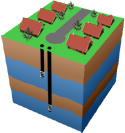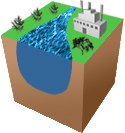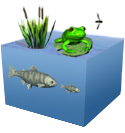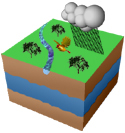|
The EPA Center for Exposure Assessment Modeling (CEAM) was established in 1987 to meet the scientific and technical exposure assessment needs of the United States Environmental Protection Agency (U.S. EPA) as well as state environmental and resource management agencies. CEAM provides proven predictive exposure assessment techniques for aquatic, terrestrial, and multimedia pathways for organic chemicals and metals. |
|
Groundwater Models
 Groundwater models quantify the movement of subsurface water and provide inputs to subsurface contaminant transport models. Simulation provides insight into groundwater and contaminant behavior and quantitative assessments for environmental decision making.
Groundwater models quantify the movement of subsurface water and provide inputs to subsurface contaminant transport models. Simulation provides insight into groundwater and contaminant behavior and quantitative assessments for environmental decision making. |
Surface Water Models
 By modeling contaminant movement and concentration in lakes, streams, estuaries, and marine environments, researchers can better understand how exposure to contaminants affects aquatic environments.
By modeling contaminant movement and concentration in lakes, streams, estuaries, and marine environments, researchers can better understand how exposure to contaminants affects aquatic environments. |
Food Chain Models
 Contaminated aquatic and terrestrial environments typically result in the bioaccumulation of chemicals within all trophic levels of an ecosystem. Software models provide tools for tracking the movement of contaminants through food chains and for estimating chemical impacts on exposed biota.
Contaminated aquatic and terrestrial environments typically result in the bioaccumulation of chemicals within all trophic levels of an ecosystem. Software models provide tools for tracking the movement of contaminants through food chains and for estimating chemical impacts on exposed biota. |
Multimedia Models
 Contaminants may travel through the atmosphere, soil, surface water, and the organisms that inhabit these media. The multimedia approach to exposure modeling quantifies the impacts of contaminants as they travel through more than one of these environments.
Contaminants may travel through the atmosphere, soil, surface water, and the organisms that inhabit these media. The multimedia approach to exposure modeling quantifies the impacts of contaminants as they travel through more than one of these environments. |
Exposure Assessment Models
![[logo] US EPA](https://webarchive.library.unt.edu/eot2008/20081105082617im_/http://www.epa.gov/epafiles/images/logo_epaseal.gif)